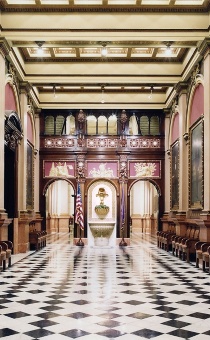Interview by Pitchaya Sudbanthad
. . .

Born on the same day in 1935, Christo and Jeanne-Claude have for decades collaborated on large-scale public art projects that impact and transform both landscape and architecture. Notable pieces have included The Gates in Central Park, Running Fence in California, and various wrapped buildings. Each project requires lengthy planning and is then on view for a very short period, sometimes only a few days. This interview is from the first edition of Museo, published in 1998.
Pitchaya Sudbanthad: Could you tell us about the early days studying art at the Academy in Sophia?
CHRISTO: Art school in Bulgaria at that time, in the late 1940s and 50s, was very conservative, very much in the mold of the art academies of the nineteenth century in Europe. Basically, you become a painter, a sculptor, or an architect in the same school, the Fine Art School. For the first four years, you studied everything: painting, sculpture, architecture, industrial design, then in the fourth year, you specialized to become a painter, sculptor, or architect. I studied all of these different disciplines.
Sudbanthad: When you look at a landscape, what makes a place perfect for a Christo and Jeanne-Claude work?
CHRISTO: There are no rules.

JEANNE-CLAUDE: It is different each time. The idea always comes from our own hearts and heads. That is why we do not do commissions or accept sponsorships. We do what we want, how we want, and where we want, but not always when we want. It took us twenty-four years to get permission to wrap the Reichstag. We had to fight ten years to wrap the bridge in Paris. The umbrella project in Japan and California took six years.
CHRISTO: You have to understand that there is no recipe. It is generated by a very personal experience. The expression for the Reichstag is one thing, the expression for the umbrellas is another thing. They are all different.
Sudbanthad: People traditionally associate the Reichstag with history. You’ve also worked on projects at Roman walls and other monuments. Do history and politics play a role in choosing your sites?
JEANNE-CLAUDE: Our works have elements that are social, political, environmental, and economic.
Sudbanthad: That’s one of the extraordinary features of your works. They are seen by so many people, many of whom might not usually walk into a gallery or a museum. In recent times, information technology is becoming more accessible, as with the Internet, and the notion of a public space is expanding to include virtual space. As artists whose works are physical, how do you see yourselves in a time when public space is gaining a non-physical dimension?
CHRISTO: The public dimension is from the exact situations that we use, the very public spaces or spaces owned by private citizens, the government, which is so many people. It is space used by the thousands and millions of people who go to that space in a short time, and we create a gentle disturbance in that space. We inherit everything that belongs to the space; it is not invented by us. The political dimension of the Reichstag was not invented by us. There are photographs of the Wrapped Reichstag. There are preparation drawings for the Wrapped Reichstag. Those are about the Wrapped Reichstag, but that is not the project. The real project was not about the Reichstag, it was the Reichstag. A film by National Geographic about lions is not the real lions.
JEANNE-CLAUDE: The film won't bite you.
CHRISTO: When you see a film about storms, snow, and natural violence, there is no real fear, no real wetness, all that is make-believe.
JEANNE-CLAUDE: There was a man who kept insisting on us doing something in Virtual Reality, and I asked him if he ever really made love to a photograph of his girlfriend.
CHRISTO: Information can be by sound or by sight, but it is all only about information. We like to do our projects because we want to be a part of that life experience. What we do now in a particular time of our lives will never be the same as what we did in the Valley Curtain project. Our emotions cannot be the same. This expedition of our life cannot be substituted. Our engineers wanted to do a virtual model of the Reichstag, and I told them that I would only pay for that if they could show how the wind would move the fabric. That movement would be so unpredictable, and they could not do it.
Sudbanthad: Speaking of the Reichstag, the project took twenty-four years to be completed. Has there ever been a point in any of your projects that you became exhausted and frustrated by the difficulties of its realization?
CHRISTO: No. Our projects have not only elements of painting and sculpture, but also architecture and urban planning. When you build a highway, it takes many years to plan and complete it. Our projects are the same. They involve the same physics, the same processes of regulations, and the same complex logistics, which is why our projects are not entirely like paintings or sculptures. Nobody discusses a painting or a sculpture before it is completed. But people talk about highways and buildings before they are completed, and our projects are the same.


















































